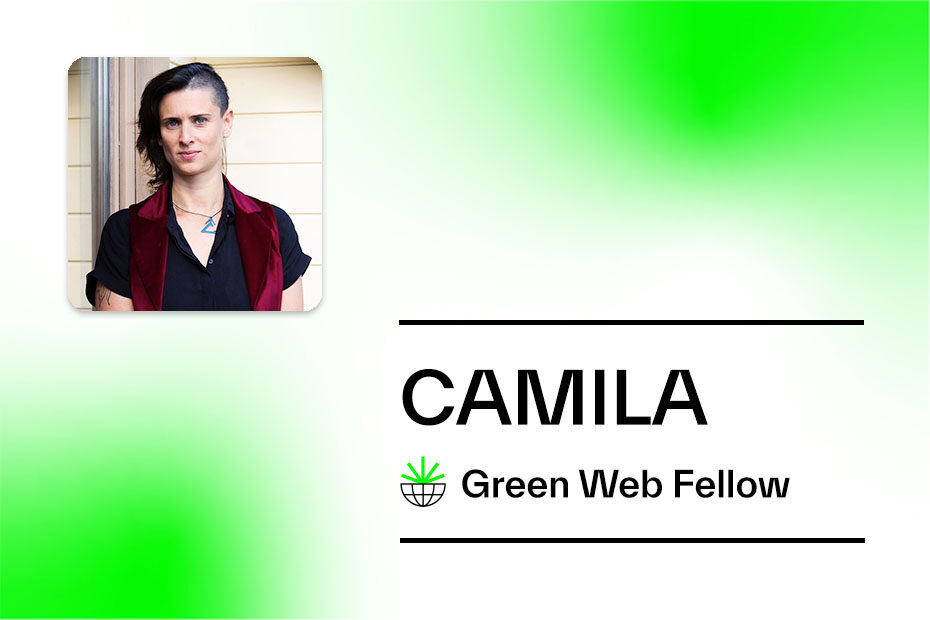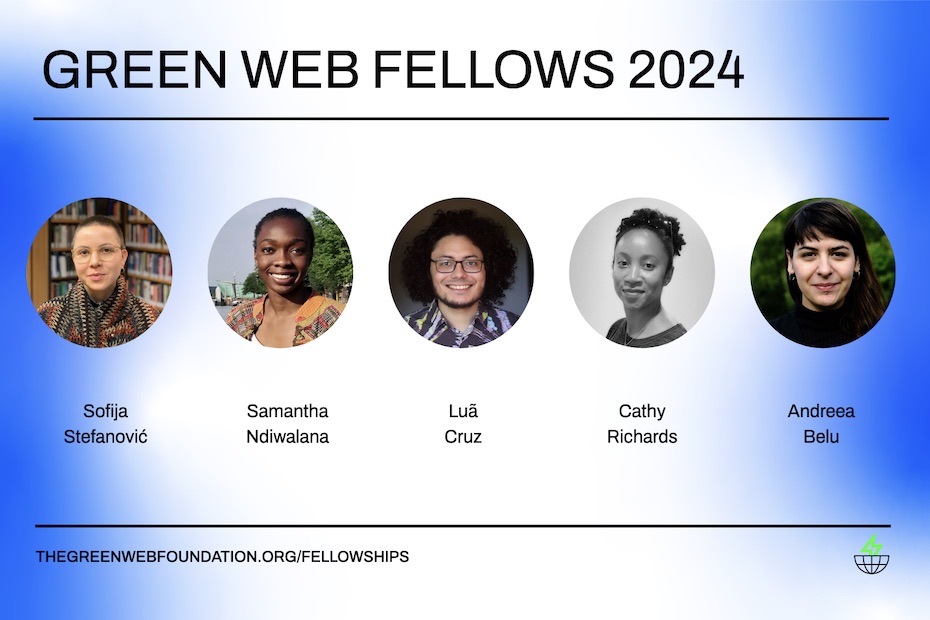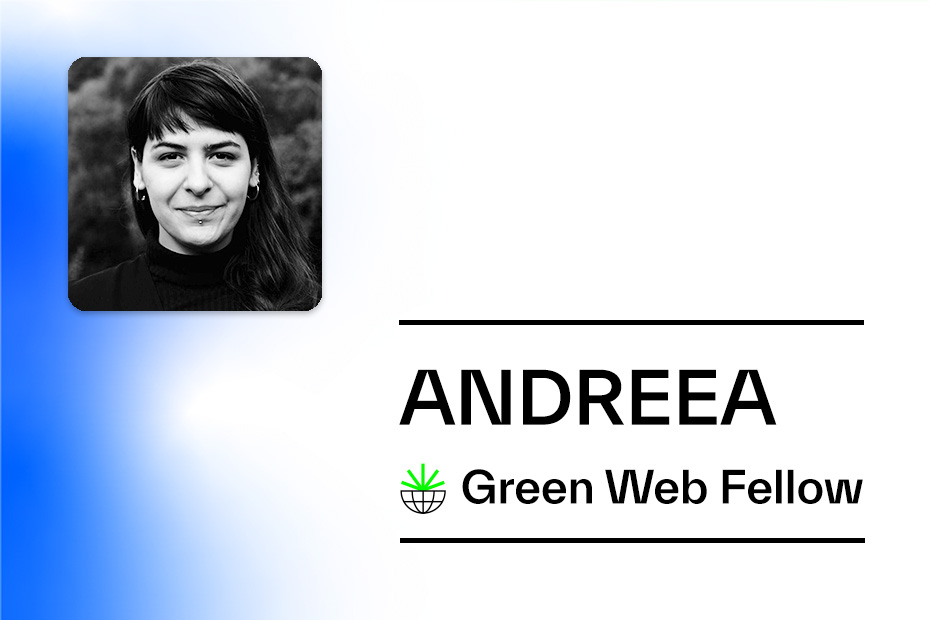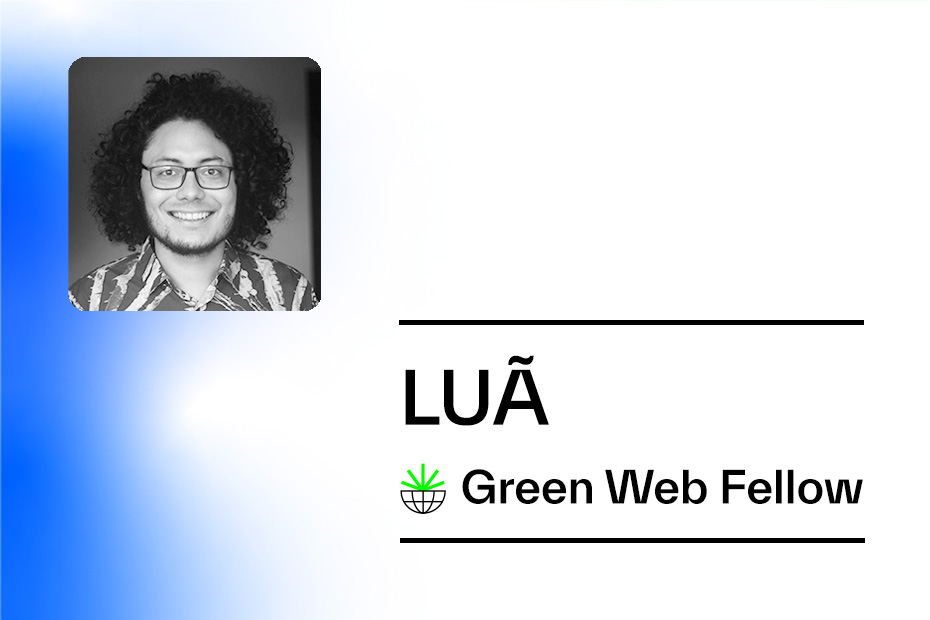Telling one story from multiple perspectives can be powerful, but building spaces that allow new collective processes of investigation can be even more powerful. This seems especially urgent when we are dealing with issues that connect territories and are situated within international webs of power, as is the case with digital infrastructures. For me, the possibility of researching both the issue and the new formats of possible investigations was one of the main takeaways of the Green Web Fellowship.
Therefore, this direction oriented the main outcomes of the fellowship. Having Berlin as a starting point to understand new dynamics of digital infrastructures, the project proposed a mix of research, storytelling from journalistic investigations through audio pieces, and the oldest social technology that nowadays sometimes is losing strength in some contexts: encounters, out of the digital space. In the format of a workshop, the aim was to unveil the structures in which we live, landing not only in transnational logics, but also in our own lives.
feminist architectures
The project had the aim to share about what I called Feminist Architectures of Investigations on Megaprojects. It is based on a lens I am developing, not alone, but as a caminhada coletiva (a collective path) through many collaborations and learning processes. Basically, it means an approach that brings power relations to the front of the study of megaprojects. It is part of Beyond the Green, a laboratoria of feminist and queer narratives to investigate the arrival of those huge infrastructures and how they affect territories, bodies, and connect dynamics in the Global South and the Global North.
So one of the main questions I had was: How not to only change our perspectives individually, but also to contribute to methods of sharing and building together? How to build a different path of investigations, not hiding our positionalities, power hierarchies and embodied narratives? On the contrary, how to bring it to the front, putting different angles together?
This project worked on encounters to build collective investigations, starting from specific cases, for example a data center in Berlin, and a submarine cable that was damaged (I tell more about that below). From that, the proposal was to expand it collectively with the participants in each encounter, according to the knowledge they bring. I am not referring to tech knowledge. In this context, it means any knowledge that helped in the process.
a temporary feminist newsroom
To start the experience, I produced three sound pieces based on a real case of the Toga island, where, in 2022, the population got disconnected from the internet for weeks. The situation was a consequence of damage to a submarine cable, actually the only one that connected the island with the internet. For this reason, the case got famous and one of the surprises it caused was the fact that it was actually possible that a place suddenly disconnected. What kind of feelings would it bring to be disconnected? What about the evidence of the dependency of oversea cables in a part of international dynamics that is kind of taken for granted? Would you escape, would you stay?
Who decides about it? From the perspectives of three main fictional characters: a woman that works fixing the cables, a group of tourists coming from Germany looking for a detox retreat, and from the island itself, we start the journey from the audio pieces. The participants of the experience are divided in groups, so each one has contact with the perspective of only one character. The invitation is that, in a second part, we start together unfolding the story, its possible connections, reflections, data we would like to gather as a group. From that, the experience lands in a temporary newsroom format in which participants decide on how the investigation should follow.
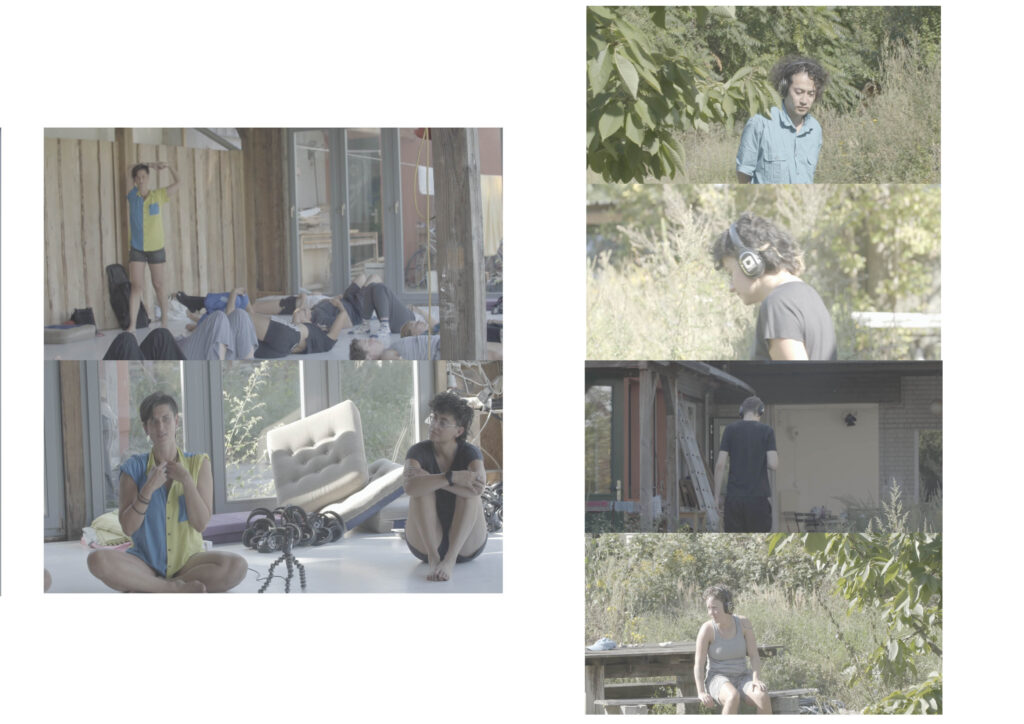
Images: Parts of the workshop Feminist Architectures – Experience 1 “Have you seen a submarine cable?”. Frames of videos by Catalina Fernandez for the documentation of the “Feral Encounters” meeting, Berlin, 2023
From the experiences so far: Some people brought specific academic data, others knew the logics of data traffic, another person started their contribution from a feeling in their body of having time captured by data infrastructure. A consensus was the doubt: How does a submarine cable look like?, that became a question one participant posed to me and the other people in the room: “Have you seen a submarine cable?” Now, this is the title of the workshop. Many collective questions unfolded, bringing cases of control of territories in other parts of the world as Latin America, on who are the ones that have power to affect dynamics in territories worldwide.
Another participant connected some information from the audio to think about macro lenses on racism or on migrant processes controlled by data. A person had a drone image of data centers in Berlin in one of their activities. Another one collected images of a submarine cable. One, a dancer, performed a movement from the movement of the cable undersea. Agreements, disagreements. A question on how much energy data centers need from dams. Every part of the puzzle matters, which means every participant has knowledge to take part.
environmental justice and digital rights. why bring them together?
In this sense, the challenge of making intersections visible between environmental justice and digital rights was a great fit. Why? Because there is no way of understanding the connections if we do not expand the angles. Or, actually, there is, but only if you want to stay on the surface and ignore issues and stories that are asking to be told and unfold.
Our data is collected in different places, stored in others. Submarine cables sustain more than 90% of the global internet infrastructure. While many studies focus on security issues behind it (such as this publication by the European Parliament from 2022), there is a lack of research on connections between digital infrastructure and its own dependency on other mega structures. Namely, energy generation, mineral extraction, land ownership.
Simultaneously, there is a gap on studies that connect the extraction of our lives, meaning time, different livelihoods, forms of social organization and so on to the advancement of such kind of infrastructures. This is the point where feminist investigations that bring colonial roots into question can help.
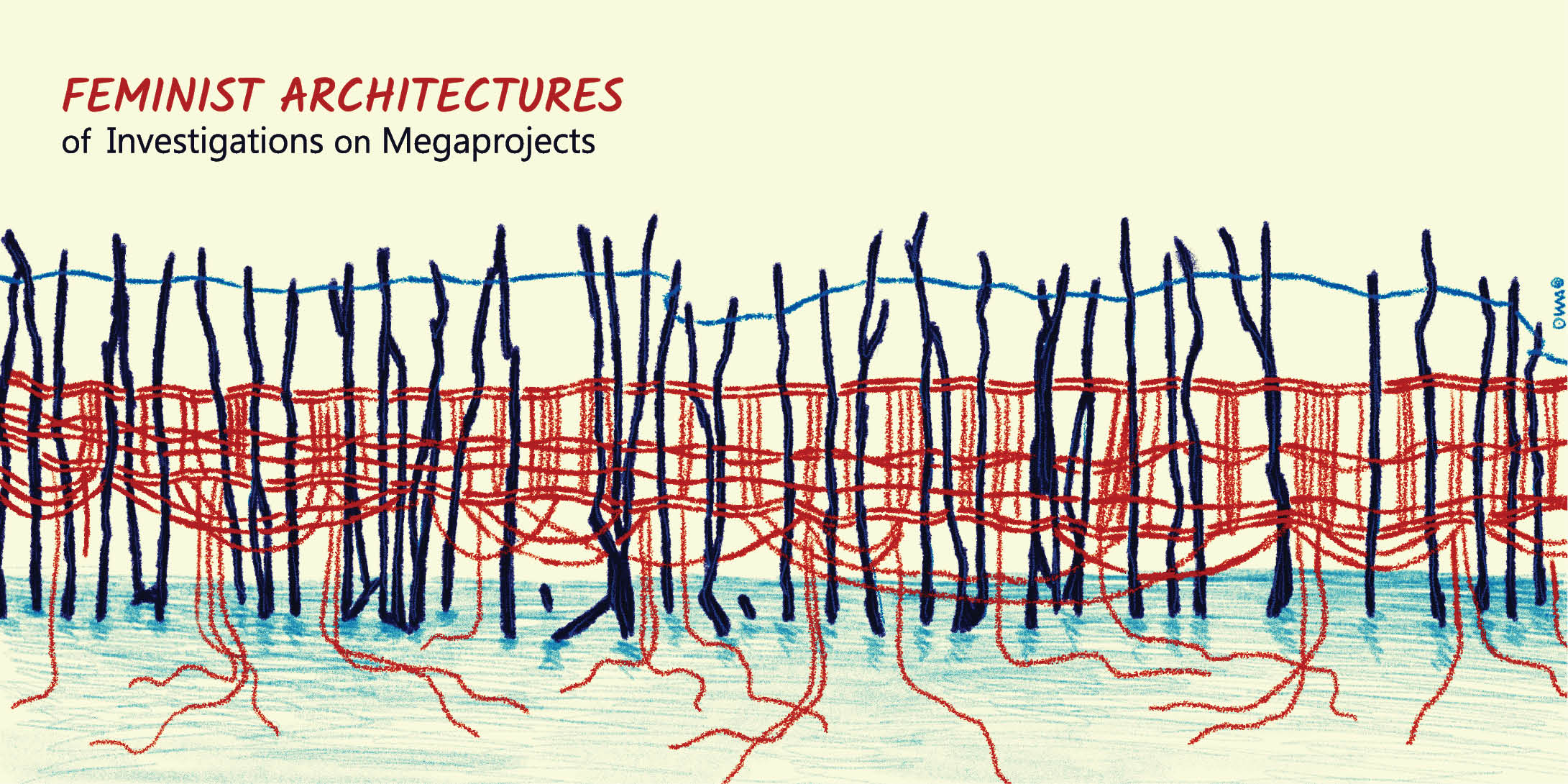
Illustration: Lua Rabello for the project Feminist Architectures of Investigations on Megaprojects / Beyond the Green
That’s the reason why I have a kind of obsession for megaprojects (For more definitions on the term megaproject, see this post) as a field of observation and investigation.
transnational lens, situated knowledge
Why a transnational lens? For instance, there is a boom of megaprojects in the Global South, for example in Latin America, where I come from, while some kinds of large scale projects are being closed or removed in European countries (where I live partially) and the United States (for instance, this is the case of dams, as it is exemplified in this article). There are ongoing struggles against data centers, like in the Netherlands, as Fieke Jansen tells in this post that contributes to unveiling politics of data centers. But how can we delve into it, complementing each other´s research and other formats of investigation from our situated experiences, as well as knowledge that we have from specific parts of transnational dynamics?
Megaprojects are huge enterprises. Usually they depend on transnational collaborations of states and corporations, are highly dependent on common goods (I don´t like the term environmental resources, as it naturalizes a neoliberal perspective on things that are not only “resources”). Besides that, in most situations they transform the lives of thousands people, in many cases not really considered during the decision making process.
Nevertheless, they are in most cases not well discussed in the public sphere. Specifically, the mutual dependence of different structures on each other is not well discussed. However, in practice, in order to understand social and power relations, I argue there is no way to study a data center or a hydroelectric plant, or even the increase in mineral extraction, without putting them together through a transnational lens.
submarine cables and colonial routes
There are many layers to be connected. For example, do you know about the relations between submarine cable routes and colonial trajectories? The artwork from Tabita Rezaire from 2017, when almost nobody was talking about that, is a good introduction to the topic. Digital and non-digital megaprojects connect people worldwide, even if the links are invisibilised.
Therefore, connecting different lenses is a powerful tool to unveil these structures. An engineer who writes reports of environmental impacts of megaprojects. A lawyer that knows about public hearing processes, or a feminist geek that understands autonomous technologies of connection. An artist working on colonial routes of new technologies. Let´s say a specialist on the disputes of digital rights in the European Parliament, a community leader that knows about the repetitive dynamics of eviction, a group of journalists.
How can we all sit together and better connect the different research and experience to get deeper into the topic? Different angles can reveal important nuances and connections. Simultaneously, their opinions can move one another, challenge certainties, shift paradigms of solutions. We can affect each other´s perspectives, and that´s what I argue is a key for a collective method of investigation.
The experience of bringing multiple worlds together, as well as the collisions (or choques) among them, as the chicana thinker Glória Anzaldúa names it.
social technologies of encounters, that´s how I read it
Kelly Saura, artist that developed curatorial accompaniment of the Feminist Architectures project
Amazing contributions from amazing women and gender dissident people shaped the project: Kelly Saura, who did a curatorial accompaniment, Lua Rabello for the illustrations, Alex Vitero and Catalina Fernandez for the feedback and consultancy on sound design and for supporting the set of the workshop “Have you seen a submarine cable” in Berlin, as well as the documentation.
It was an amazing learning process and I thank not only the team of the Green Web foundation for all the generous spaces for sharings we had, feedback and support, but also all the other fellows. We were a group that really exemplify how broad the topic is, and how different perspectives and expertises sometimes really make us formulate new questions and pathways.
